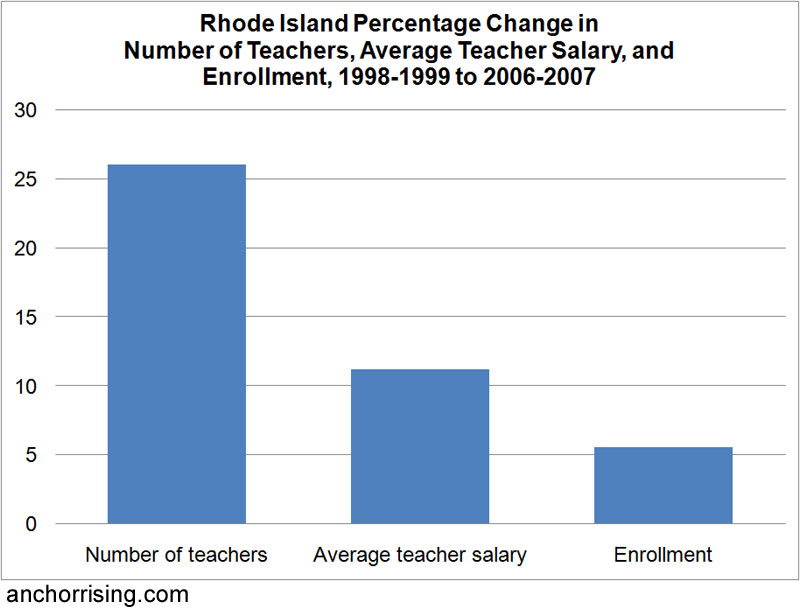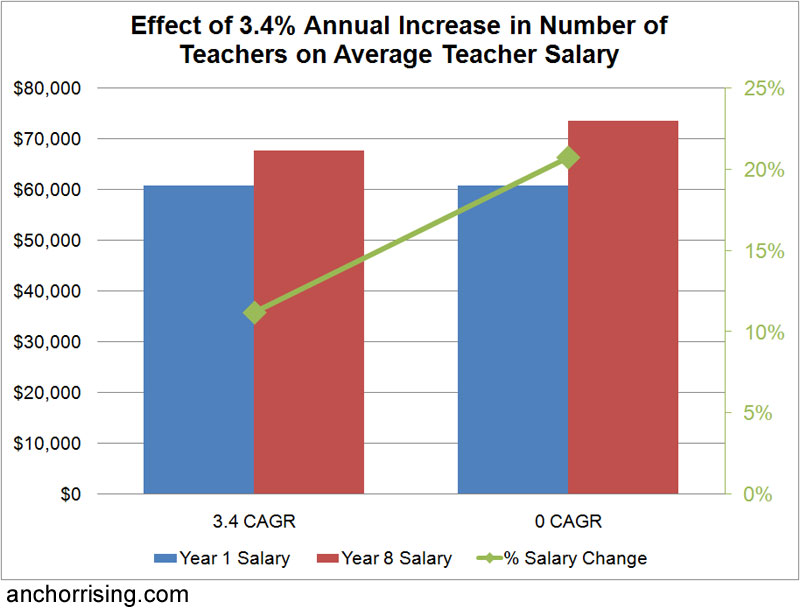NEA-RI Future Illusions with Averages
Mr. Crowley has been on the attack, lately, so it’s pleasant to see him turning toward attempts to actually make a case on behalf of those for whom he advocates. Yesterday, he presented some National Education Association numbers (I know, I know) thus:
This first chart shows that over the last decade, teachers [across the nation] have earned annual increases 2.85%. Sounds fairly modest, right? …
Now look at this [other] chart. It looks at teaching salaries over a 20 year period, from 1989 to 2009. If you look at the actually dollar amount, the range starts in 1989 at $29,564 and ends in 2009 at $53,910. But, when you look at the same time period and use constant dollars (that is, taking inflation into account), the dollar value in 2009 would be $204 less than what is was in 1989.
Crowley doesn’t link to his source, but several previous iterations of the NEA report are available here, and the first thing to note is that the first chart isn’t the data for “teachers,” but for “instructional staff”, which includes, as written in the 2007 report (PDF):
… classroom teachers, principals, supervisors, librarians, guidance and psychological personnel, and related instructional workers.
I point this out for clarity only, inasmuch as the annual increase is pretty much the same if limited to teachers. Both pretty much track with inflation.
It’s the second paragraph of the quotation from Crowley that ought to be surprising to anybody who’s followed the issue of teacher employment and contracts, because contracts typically increase the pay allocated for each salary step by inflation or better each year, plus teachers move up the steps as they go. It would therefore be astonishing to learn that they are barely keeping up with the consumer price index (CPI). The matter is more striking, today, as Crowley has focused in on Rhode Island:
… looking at the last ten years, Rhode Island teachers saw smaller salary increases than their peers around the country. As the chart shows, the national average gain for the last ten years was a 32.9% total increase in salary. For Rhode Island, the total increase in salary was 29%, placing us 33rd in the nation. …
How does this translate into constant dollars [adjusted for inflation]? Well, nationally, the decade from 1997 through 2008 saw teachers lose 0.6% in salary. Rhode Island teachers, in constant dollars realized a loss of 3.5%. That’s going backwards.
If that just sounds wrong, well, it’s because it is, and here’s why:

One helpful byproduct of the union’s salary step system is that the trends for individual teachers are reasonably predictable. Increasing the number of classroom teachers by 26% over eight years pulls the “average salary” downward, even though everybody involved is making more money. That’s how Rhode Island managed to be number 9 in the nation in average teacher salary in both the 97/98 and 05/06 school years even though it was number 25 for its percentage change over that decade: Our number of teachers increased at twice the national rate, even though our enrollment increased at the national rate.
For illustration purposes, I put together the following chart. Because I had them handy, I began with the latest Woonsocket salary step amounts, guessed at the ratios at each step, and assumed 5% annual retirement and a 2.8% increase in steps each year; these assumptions result in comparable change numbers to those that the NEA reports. Lowering the retirement assumption would increase the effect (because a higher percentage of teachers would remain at step 10). The 2.8% increase in steps is probably low; picking two years for which data is available for all districts but Warwick, from 2004 to 2005, the overall average step in RI went up 3.3%. However, the goal was to model the NEA’s results, and this puts the steps pretty much at inflation. For simplicity’s sake, I disregarded other considerations like longevity, activity pay, and higher-degree adjustments.

With the very same step increases, if the state had only replaced retiring teachers, the increase in the “average salary” would have changed from 11.2% to 20.8%. If districts had hired even more teachers, the average salary would have increased less. In other words, this “average” has little relevance to the financial well-being of individual teachers, and it’s bizarre to claim that they “realized a loss.” The steps at least paced with inflation, and a teacher who hit step 10 in Year 8 would be receiving twice the pay she or he did in year 1.
And here’s the kicker: None of this touches on benefits.

Like they say, liars figure and figures lie. As usual, Crowley is doing a lot of figuring. He figures we don’t know the truth that top step teachers in Cranston, for instance, make about $73,000 – before benefits. You get to a top step in about 10 years.
So much for his stupid charts.
I don’t know where the NEA gets their “average salary” data from, but it has always been way off when it comes to RI. Average teacher salary here has always been 35-40% higher than those NEA numbers. These NEA numbers are so far off that they would seem to be useless for the purpose of any worthwhile analysis here in RI.
Take a municipality’s total amount “contributed” toward teachers health care and other insurance, other benefits, payroll AND “contribution” to the pension fund (the greater of actual contribution or what the actuaries say they should be contributing), and then divide by the number of teachers.
That’ll give a pretty good “average” of compensation (of which their salaries are only part).
Oh yeah, then prorate that amount to account for only a 180 day work year.
How’s this for a timely article from the Wall Street Journal regarding the likely bankruptcy filing of the Detroit Public Schools: http://online.wsj.com/article/SB124813472753066949.html
One of my favorite lines: “It also would give Mr. Bobb broad latitude to tear up union contracts without protracted negotiations.”
Here is another: “Behind DPS’s predicament are many of the same problems that have haunted the city’s auto industry for years: excess capacity, high labor and pension costs, fleeing customers, ineffective management, outside competition and — except for a handful of respected programs — a reputation for low quality.”
Ahh, yes – the great union legacy. It must make Crowley proud.
It’s only a matter of time when this eventuality comes to a city near you.
Look for the union label:
CH. 11.
CH. 9.
CH 7.